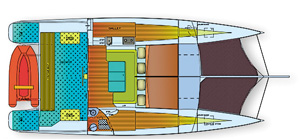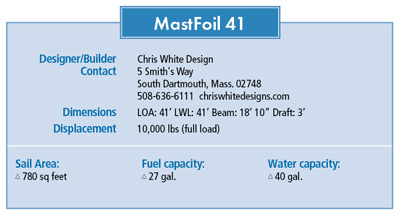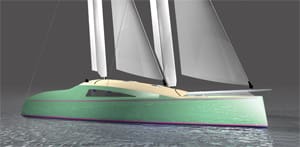For multi-hull designer Chris White of South Dartmouth, Mass., every now and then just the right client for a new design comes along.
Ideally, it is an experienced sailor with many years of boat ownership and many miles under his keel who knows what he or she wants and why they want it. In working with someone like this, extreme design concepts are factored out. At one extreme are catamarans designed for the charter trade. These tend to be maximized for interior volume, sacrificing both good looks as well as performance. On the other extreme is the racing cat, a boat stripped down to all but the basics and built solely for speed. The result here is a boat that is unsuitable for cruising.
As it happened, White was approached by an experienced catamaran sailor who has sailed and lived aboard a 45-foot cat and knew what worked and didn’t work in the real world.
The client’s requirements echoed those of many experienced voyagers whether inclined toward cat, multi, or monohull rig. The common mantra seemed to be good looks, ease of handling, simplicity and excellent performance both under sail and power.
Low profile
In terms of good looks, White designed a low, sleek profile without compromising the seaworthiness that comes with high underwing clearance and sufficient freeboard.
As for handling, the boat will be rigged with the single-handed sailor in mind. The rig is designed for self-tacking and all sail controls are led to the cockpit.
The single greatest advantage of the MastFoil rig is that there is no mainsail to hoist, reef, or furl.
The MastFoils provide significant drive to the sail plan and excellent performance even when used alone and without roller furled “soft” headsails in strong winds. Additionally, the rig is two-masted and as such, balance can be achieved on any point of sail by adjusting sail area fore and aft. At anchor, with the aft MastFoil locked in position on the centerline, the boat will ride head to wind, eliminating the need to rig an anchor bridle.
 |
|
Chris White’s layout for the Mastfoil 41 provides accommodation space for two couples. The low-profile pilothouse affords the helm unrestricted visibility. |
Two flavors of cat
In terms of accommodations, catamarans typically come in two flavors — those with an enclosed bridge deck structure, and those that utilize smaller crossbeams and open netting. While the netting configuration is simple and lighter, it eliminates most of the opportunity for a comfortable, secure cockpit and useful living accommodations. But adding an enclosed bridge deck creates its own problems. Chief among them is that when the cockpit is located aft of the deckhouse the forward visibility is poor or non-existent unless the helm position is raised. Raising the cockpit to see over the house raises the overall height of the boat, which increases windage and weight, and detracts from the aesthetics of the design. White’s solution is to keep the deckhouse low for less windage, overall weight, and aesthetics.
To keep the profile low while maintaining essential underwing clearance, the standing headroom of the MF41 is limited to the hulls where it is most needed — the galley, the head, and adjacent to the double berths. The deckhouse overhead is low, since the space consists primarily of the settee and double berths where people are mainly sitting or lying down. The reduction in height achieves unobstructed forward visibility from the cockpit.
Interior layout
The interior layout is simple and comfortable. There is a decent-sized galley in the after section of the port hull. Opposite the galley in the starboard hull, there is a head with shower and vanity. The cabins are located in the forward section of each hull. The space forward of each double cabin is available for storage or a single bunk.
The settee area is located between the hulls. There is a drop leaf table that when extended will seat six.
To maximize performance both under sail and while powering, carbon fiber is used extensively in the design to reduce weight.
White says that with the MastFoil rig, the windward sailing performance is about equal to that of a conventional sloop rig. This has been confirmed in a detailed CFD (Computational Fluid Dynamics) analysis done by Doyle CFD, a sub-group of Doyle Sails. Numerical comparison of a conventional rig and MastFoil rig in the new Atlantic 47 catamaran indicated differences on the order of 1 percent — essentially no difference.
For auxiliary power, White is suggesting twin 20-hp marine diesels for cruising speed and maneuverability. He adds that the MastFoils will also contribute to the boat’s range and power performance as they can be easily trimmed.
 |

